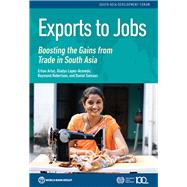Exports to Jobs Boosting the Gains from Trade in South Asia
, by Artuc, Erhan; Lopez-Acevedo, Gladys; Robertson, Raymond; Samaan, Daniel- ISBN: 9781464812484 | 1464812489
- Cover: Paperback
- Copyright: 2/25/2019
South Asia has grown rapidly with significant reductions in poverty, but it has not been able to match the fast-growing working age population, leading to lingering concerns about jobless growth and poor job quality.
Could export growth in South Asia result in better labor market outcomes? The answer is yes, according to our study, which rigorously estimates—using a new methodology—the potential impact from higher South Asian exports per worker on wages and employment over a 10-year period.
Our study shows the positive side of trade. It finds that increasing exports per worker would result in higher wages—mainly for better-off groups, like more educated workers, males, and more-experienced workers—although less-skilled workers would see the largest reduction in informality.
How can the benefits be spread more widely? Our study suggests that scaling up exports in labor-intensive industries could significantly lower informality for groups like rural and less-educated workers in the region. Also, increasing skills, and participation of women and young workers in the labor force could make an even bigger dent in informal employment.
The region could achieve these gains by: (i) boosting and connecting exports to people (e.g., removing trade barriers and investment in infrastructure); (ii) eliminating distortions in production (e.g., by more efficient allocation of inputs); and (iii) protecting workers (e.g., by investing in education and skills).






